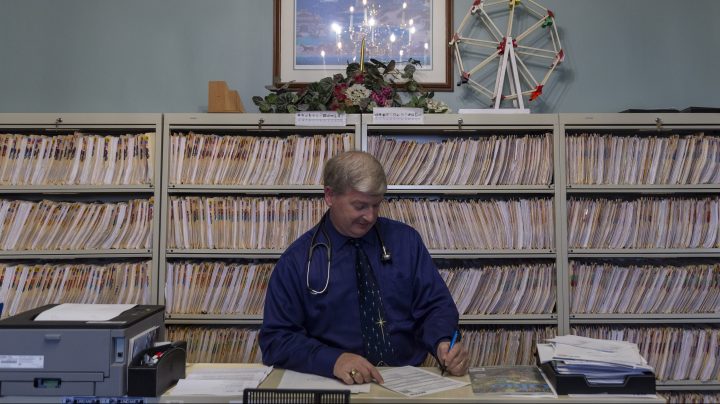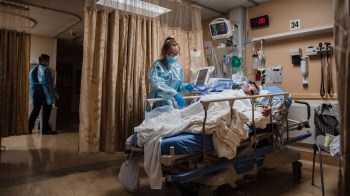
Omicron is straining medical supply chains and this small practice
Omicron is straining medical supply chains and this small practice

It took just seven days for the number of COVID-19 cases in the United States to double. The recent surge has increased hospitalizations by 50%, led to shortages of testing supplies and overburdened health care workers.
Scott Anzalone, a family physician in Logan, Ohio — and one of 10 people “Marketplace” started following in a series called “United States of Work” — recently spoke with host Kai Ryssdal about imbalances in supply and demand at his independent medical practice. The following is an edited transcript of their conversation.
Kai Ryssdal: So, let me ask you this: When somebody walks into Stagecoach Family Medicine, what happens to him or her?
Dr. Scott Anzalone: So, our regular patients that are coming in for routine care, they come into the front door and get checked in just as we normally do. In the back of our office, we have a back entrance and if you want to call it a “COVID room” or “safe room.” But overall, you know, we do get patients cared for. Where we’re running into problems is if someone is sick enough and they need to be hospitalized, that’s where we’re running into issues. We’re in a rural community. If they’re sick enough and they can’t stay at our local facility, it’s a matter of trying to find a COVID bed in Columbus or, you know, near a neighboring hospital. I had one patient recently, about 55 years old. I think four hospitals they contacted refused his transfer. He finally did find a hospital, they took him eventually, [but] he did end up passing away.
Ryssdal: How much of your time do you figure you and your staff are spending trying to find a spot for these people who need the next level of care?
Anzalone: Yeah, well, it kind of falls onto our ER physicians [at the local critical access hospital]. So, on our end, we’re dealing more with the outpatient needs. Those that are outpatient and qualify for the monoclonal antibody infusions, we do have that available … well, I should say, we have it available if it’s available at the hospital, but they only get so many doses a week. If I’ve got someone and I call over to our supervising nurse, it’s not uncommon for them to tell me “We don’t have enough staff today” to see that patient to do the infusion. You know, they’ll get to it when they can, and it may be the next day. So between getting them tested, if we need them tested, getting them at least an appointment at the hospital to get the infusion, if needed — it is an orchestration.
Ryssdal: Yeah. Let’s talk actually about the tests and the antibodies and all the stuff you need to treat the people in your care. I hate to bring this up, but it’s like a supply chain thing.
Anzalone: Part of it is, yeah. I had one patient who was in Cincinnati trying to come home for the holidays and there was not a test to be found anywhere in the entire city. Outside of COVID, I guess it’s all interrelated. I’m getting calls from our pharmacy, not too infrequently, that medications are back ordered. Specifically, a lot of these have been high blood pressure medications or hypertensives. For some of my patients, nothing else works but the combination that they’re currently on. I’m sitting there scratching my head when they tell me it’s not available, like, what do I do?
Ryssdal: So, let me ask you a bigger-picture question. You have a side hustle, you’re a clinical professor and you teach medicine. And I wonder what you think the last two years will mean for the future of the medical profession. Because we’ve heard about the burnout, we’re now hearing from you, I mean, what are students that you’re talking to saying?
Anzalone: Well, the sad thing is — it’s unfortunate — we know we really need more primary care, but the current market right now is really pushing our students into more sub-specialties.
Ryssdal: So let me ask you this, just to bring it back to you. Now, we’ve talked before about how you’re looking for somebody to take your practice. You’re thinking about retiring, and how’s it looking now?
Anzalone: Yeah, well, I’m not planning on retiring anytime soon. But I’m looking at my 10-year plan here. I am looking for a partner, and you just can’t find them. You know, I’ve got a practice that’s busting. The average family physician, usually the ratio is about 1-to-2,500 patients to physician, and I’m about 1-to-4000.
Ryssdal: That’s not sustainable.
Anzalone: I’m tired. It’s tiring, and I have really felt it in the last several months, but we got to keep moving.
There’s a lot happening in the world. Through it all, Marketplace is here for you.
You rely on Marketplace to break down the world’s events and tell you how it affects you in a fact-based, approachable way. We rely on your financial support to keep making that possible.
Your donation today powers the independent journalism that you rely on. For just $5/month, you can help sustain Marketplace so we can keep reporting on the things that matter to you.


















